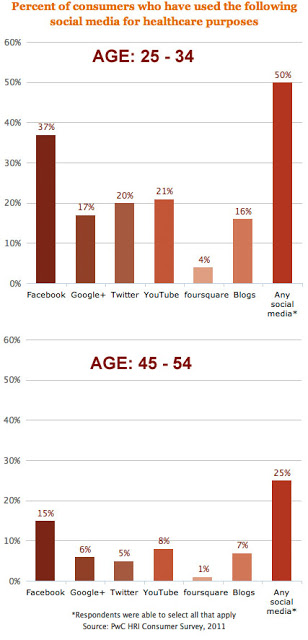A Twitter pal suggested I would “enjoy” this Los Angeles Times article: “Consumers using social media for medical information, report says.” The report from PwC’s Health Research Institute found that “one-third of consumers are using Facebook, Twitter and other social media sites to seek medical information, discuss symptoms and express their opinions about doctors, drugs and health insurers.”
This sounds like good news for pharmaceutical marketers who want to “engage more with consumers online since they are increasingly making medical decisions based on the information they find there.”
While surfing the Health Research Institute’s web site for the details, I stumbled upon a chart summarizing a previous survey of 1,000 US adults in the fall of 2011. The chart, which I found here, allowed me to segment the data by age and gender, which are two demographics that are very important to the pharmaceutical industry.
First of all, most pharma marketers want to reach an somewhat older population who are most likely to be suffering from some medical condition for which new drugs are being developed – type 2 diabetes, for example.
Here are the data for two age groups (25-34 and 45-54):
I imagine that the 45 to 54 age group is the “sweet spot” for pharmaceutical marketers. According to this survey only 25% of consumers in that group uses any type of social media for healthcare purposes.
NOTE: Comparable data from Manhattan Research’s Cybercitizen Health® U.S. 2011 study, suggests that 65% of U.S. adults in the 25-34 age group use health-related social media, whereas 43% in the 45-54 age group use health-related social media. It should be noted that MR focused on consumers who have created or consumed health-related user-generated content on blogs, social networks, health ratings websites, online health communities and message boards, or patient testimonials, whereas PwC focused only on the six specific social media sites indicated in the above charts.
IMHO, the PwC data is more useful to pharmaceutical marketers interested in reaching consumers via social media. Often, online health communities and message boards — which are included in the MR anlaysis — are not accessible to unregistered users and search engines and are therefore of limited benefit to advertisers (see “Data Mining in the Deep, Dark Social Networks of Patients“).
Women are also very important to pharma marketers — they are the caregivers and make most of the health decisions for their families. Here are the data comparing the use of social media for healthcare purposes for women versus men:
This is a surprise. First, I was lead to believe that women dominate social media (see, for example, “How to Score With Women (as a Marketer) via Social Media“). Well, that may very well be true for general use, but a significantly greater % of men use social media for healthcare purposes than do women if we believe the data shown here. Twitter is not favored by women at all!
NOTE: MR data from a survey cited above says that 45% of BOTH U.S. adult men and women use “health-related social media.” Again, I think MR includes social media sites in its data that are not very relevant to pharmaceutical marketers (see note above).
This is not good news for the marketers in the pharma industry who proselytize the use of social media. Beware of the Kool-aid being served!










![6 Digital Tools at the Center of Healthcare Digitalization [INFOGRAPHIC]](http://ec2-54-175-84-28.compute-1.amazonaws.com/pharma-mkting.com/wp-content/uploads/2021/04/6DigitalTools_600px-100x70.jpg)




